True Romance was one of the defining films of the nineties, depicting two young lovers on the run in a spate of bad taste that looked unbelievably good. But how did a film that was a flop at the box office put Tarantino on the map, become a cult classic, and epitomise over-the-top, All-American trash culture? We delve deep into the style legacy of Tony Scott’s 1993 romantic crime thriller and find out how…
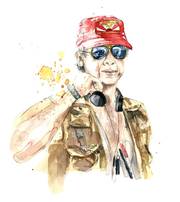
DIRECTOR PROFILE: TONY SCOTT
BORN - 21st June 1944, Northumberland, United Kingdom
DIED - 19th August 2012, Los Angeles, USA
ROUTE INTO FILM - Graduated from the Royal College of Art with the intention of becoming a painter, but went to work for his brother’s film company initially making commercials before finding success.
KNOWN FOR - Top Gun (1986), Beverly Hills Cop II (1987), Enemy of the State (1998), Man on Fire (2004), The Taking of Pelham 123 (2009), The A-Team (2010)
FAMOUS QUOTE - "The biggest edge I live on is directing. That’s the most scary, dangerous thing you can do in your life."
"Stealing, Cheating, Killing. Who said romance is dead?" reads True Romance’s tagline. With all the makings of a Hollywood blockbuster, Tony Scott’s 1993 cult classic has worked its way into the zeitgeist and is widely considered a lurid view into early-90s America. It follows the path of loved-up duo Clarence and Alabama as they go up against the world, the latter a call girl originally hired by the former’s boss for his birthday. Having met at the movie theatre, Clarence, played by Christian Slater, and Alabama, played by Patricia Arquette, fall in love and in a whirlwind get married the next day.
Alabama’s pimp Drexl and his partner beat up Clarence, leading to our heartthrob protagonist killing him in revenge. Taking what he assumed was a bag of Alabama’s possessions, Clarence inadvertently steals a heap of cocaine, pitting the duo against the mob in a game of cat and mouse that ultimately leads to their escape, both loved- and moneyed-up to Mexico. It’s fast-paced, it’s full of action, and it’s undeniably a true romance, but it’s also full of nods to an America that had sat culturally dominant throughout the 20th Century and was fast heading towards a new millennium...
THE ‘ALOHA’: PATTERNED OPEN-COLLAR HAWAIIAN SHIRT
Think about the true classics of Americana and the Hawaiian shirt, or Aloha shirt as it was originally known, is bound to feature. Its connotations are strictly casual, and it’s perhaps the most significant part of our caricature-like protagonist Clarence’s wardrobe. But the famously loud summer staple has its own surprising origin: Japan. Originally sewn from imported kimono fabric, the Aloha first appeared on the streets of Honolulu in the early years of the 20th century, sold out of a garment store established by a Japanese immigrant. It wasn’t long until the modern Hawaiian shirt was being produced, and in the early 1930s newspapers such as The Honolulu Advertiser featured spreads pedalling the bold garment. Local residents and surfers popularised it, and soon an industry worth millions in today’s terms was dedicated to the product.


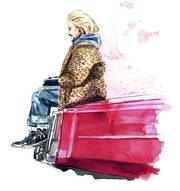
TRASH CULTURE - WASHED DENIM, LEOPARD PRINT AND CONVERSE
Trash culture saw a popular emergence during the 1980s, so it’s only fitting that Alabama’s whole aesthetic embodied the term. Preserve of the socialites and Hollywood A-listers, back when Hollywood had real glamour, leopard print sits at the centre our call girl’s look. Even Dionysus, the Greek god of wine, was associated with the stuff, but has there ever been a garment or print that’s faced so much contention as to whether it’s in good or bad taste? Take a bit of Hollywood glamour, add in mass manufacturing and synthetic fibres, and everyone can have a piece of the action. Even a call girl like Alabama.
By the time Tony Scott was making True Romance, the Berlin Wall had crumbled, computer technology had started to gain traction and MTV was king, slowly but surely reshaping pop culture and how American’s viewed the world around them. As the ‘90s came around, image obsession became the norm through the proliferation of cable television. The more Americans were exposed to celebrity culture in ever-greater volumes, the more they wanted a piece of the pie. Many wanted to dress in a striking and showy manner, albeit without having the cash to match. Consumer culture played perfectly into people’s desire to seek luxury and it provided them with the cheap imitations to substitute. It’s perhaps the scene where Alabama’s sat on the boot of a pink Cadillac in washed denim, leopard jacket and Converse that so perfectly sums up this idea of ‘90s ‘cheap richness’.
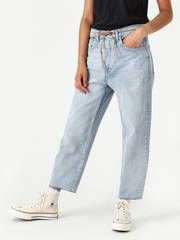

THE JACKIE LOOK
LEOPARD PRINT HAS ADORNED THE BACKS OF MANY A-LISTERS AND INFLUENTIAL PEOPLE, BUT PERHAPS ONE OF THE MOST FAMOUS EXAMPLES OF THE PATTERN IS JACKIE KENNEDY’S OLEG CASSINI COAT. CASSINI DRESSED NUMEROUS HOLLYWOOD STARS, FROM MARILYN MONROE TO RENEE ZELLWEGER, BUT HE WAS BEST KNOWN FOR CREATING KENNEDY’S DEFINING LOOK.

ALL-STAR CAMEO
AFTER APPEARING IN THELMA & LOUISE IN 1991, DIRECTED BY TONY SCOTT’S BROTHER RIDLEY, BRAD PITT ASKED TONY IF HE COULD PLAY THE PART OF FLOYD, MICHAEL RAPAPORT’S STONER ROOMMATE. HE GOT OFFERED THE PART AND IMPROVISED MOST, IF NOT ALL, OF HIS LINES.
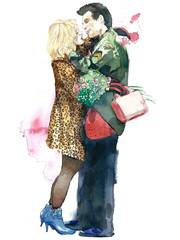
THE MILITARY FATIGUE JACKET - VINTAGE AMERICANA
It’s not only The King’s laid-back Hawaiian number that Clarence sought to imitate; True Romance’s earlier scenes see a field jacket hanging from our protagonist’s back. Whilst the film’s costume designer Susan Becker (of earlier St. Elmo’s Fire fame) purposefully decked Clarence out in ‘50s attire, his jacket is another reference to his obsession with the King. Vintage militaria has always been a common thread throughout 20th-century menswear, but the field jacket is another garment that found particular fame through celebrity association.

Robert De Niro may have worn one in 1976’s Taxi Driver, but it was surely Elvis who started the trend. Already famous by the time he served in the US Army, he was photographed in the classic M-51 throughout his short military career, most famously whilst serving in Germany. As a style icon of the time, he only further spread the influence of militaria.
PIMP SWAG - BERET, LEOPARD PRINT AND DREADS
Perhaps one of the most surprising parts of True Romance is Gary Oldman’s appearance as Drexl, a grotesque yet decked-out white Rastafarian pimp with a wonky eye. Very much straddling the line between good and bad taste, Drexl is probably the best example of ‘pimp swag’ you can find in Hollywood. And it all lies with Oldman himself. Oldman was offered the role whilst working on other projects and without having read the script. He and Scott didn’t have time to meet prior to filming either, meaning Oldman had to piece together the character himself. In effect, Oldman assembled dreadlocks, gold teeth and a fake eye he'd previously worn in Dracula and paired them up with a leather beret, yet more leopard print and all manner of rings and necklaces.
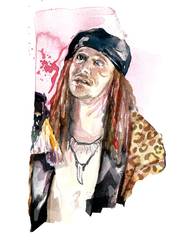

THOSE SUNGLASSES
BOLD SUNGLASSES MAY HAVE TOPPED OFF OUR DUO’S LOOKS, BUT IT’S CLARENCE’S ELVIS REPLICAS THAT MAKE AN APPEARANCE IN KILL BILL. BEATRIX KIDDO IS SEEN LEAVING THE HOSPITAL SPORTING THE EXACT SAME PAIR USED IN THE FILM. SUCH AN APPEARANCE ISN’T SURPRISING THOUGH – QUENTIN TARANTINO WROTE TRUE ROMANCE’S SCRIPT...

VIDEO ARCHIVES
TARANTINO ACTUALLY WROTE TRUE ROMANCE WHILST WORKING AS A VIDEO STORE CLERK SURROUNDED BY EIGHTIES BLOCKBUSTERS, WHICH GOES A LONG WAY TO EXPLAINING THE WHOLE ‘HOLLYWOOD-ON-CRACK’ DYNAMIC. VIDEO ARCHIVES WAS LOCATED IN MANHATTAN BEACH, CALIFORNIA, AND PROVIDED THE YOUNG TARANTINO WITH A SALARY WHILST STUDYING ACTING AT ALLEN GARFIELD’S ACTOR’S SHELTER.
HYPER CINEMA
True Romance embodied Hollywood and wider American culture at a time when it was accelerating unlike ever before. But for all the film’s seemingly outrageous ideas, from falling in love with the prostitute your boss hired for your birthday to absconding to Mexico post-shootout, True Romance struck a chord with the audience and is widely considered one of the defining films of the nineties. It’s perhaps this idea of ‘hyper cinema’ where it does best; if Tarantino at his peak was able to define the art of film, then starting out he was certainly able to play with and accentuate the sort of subplots and themes that gave Hollywood’s hits their shine. Maybe that goes some way to explaining the over-the-top, 'hyper' style of our Bonnie and Clyde duo. Ultimately, True Romance is Hollywood through and through, even if it is adding a touch of glamour and cool to something that’s a little bad taste...
















